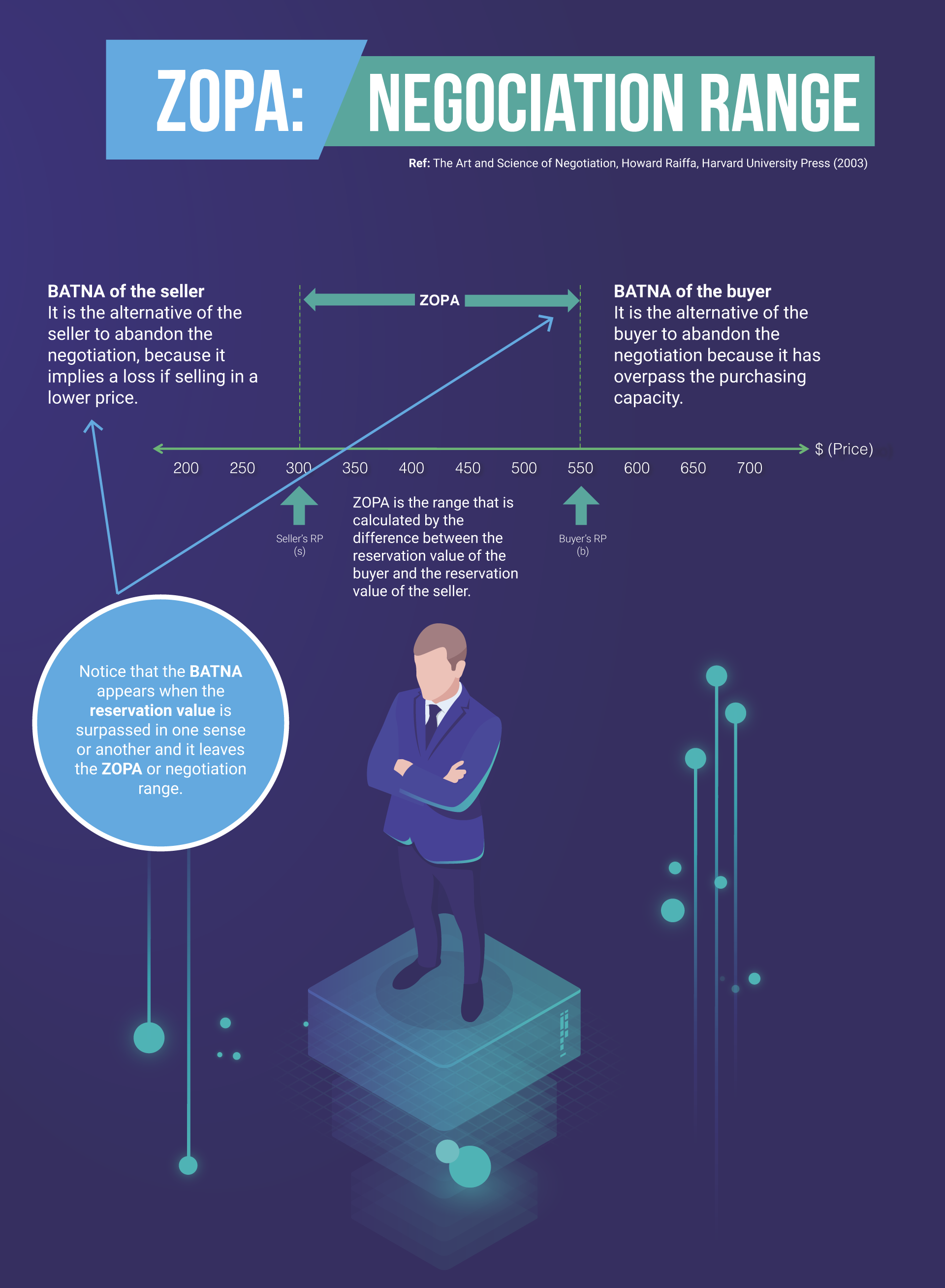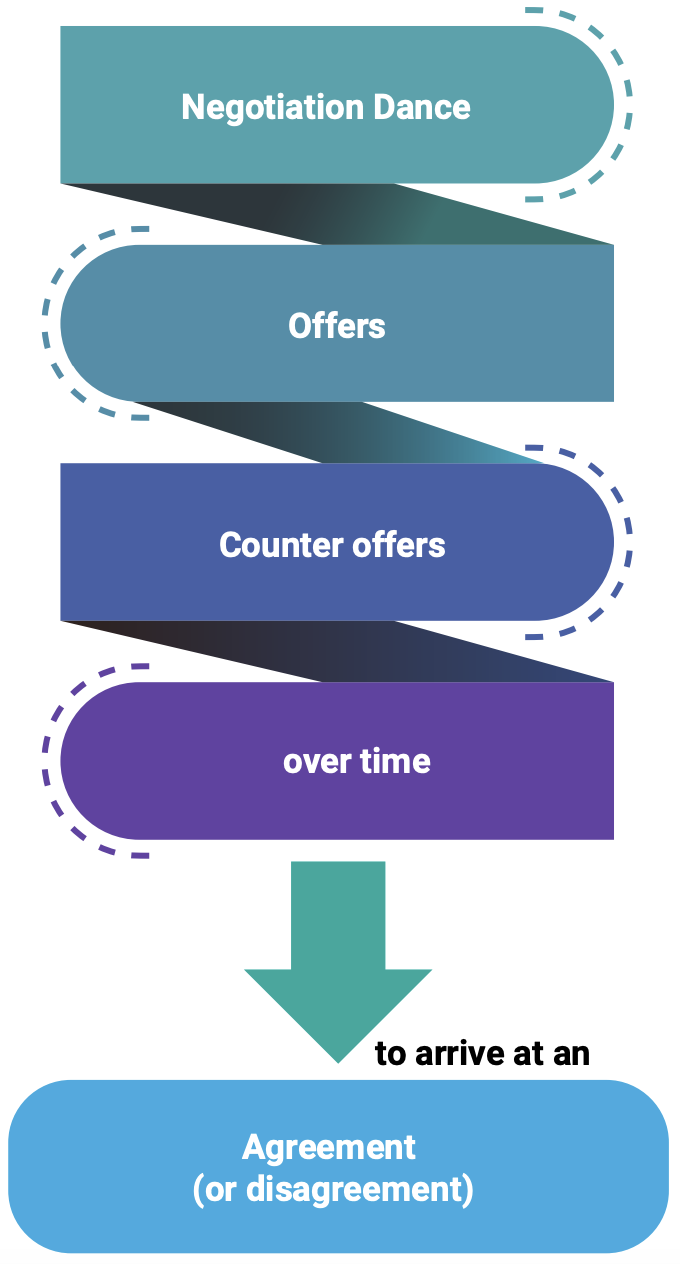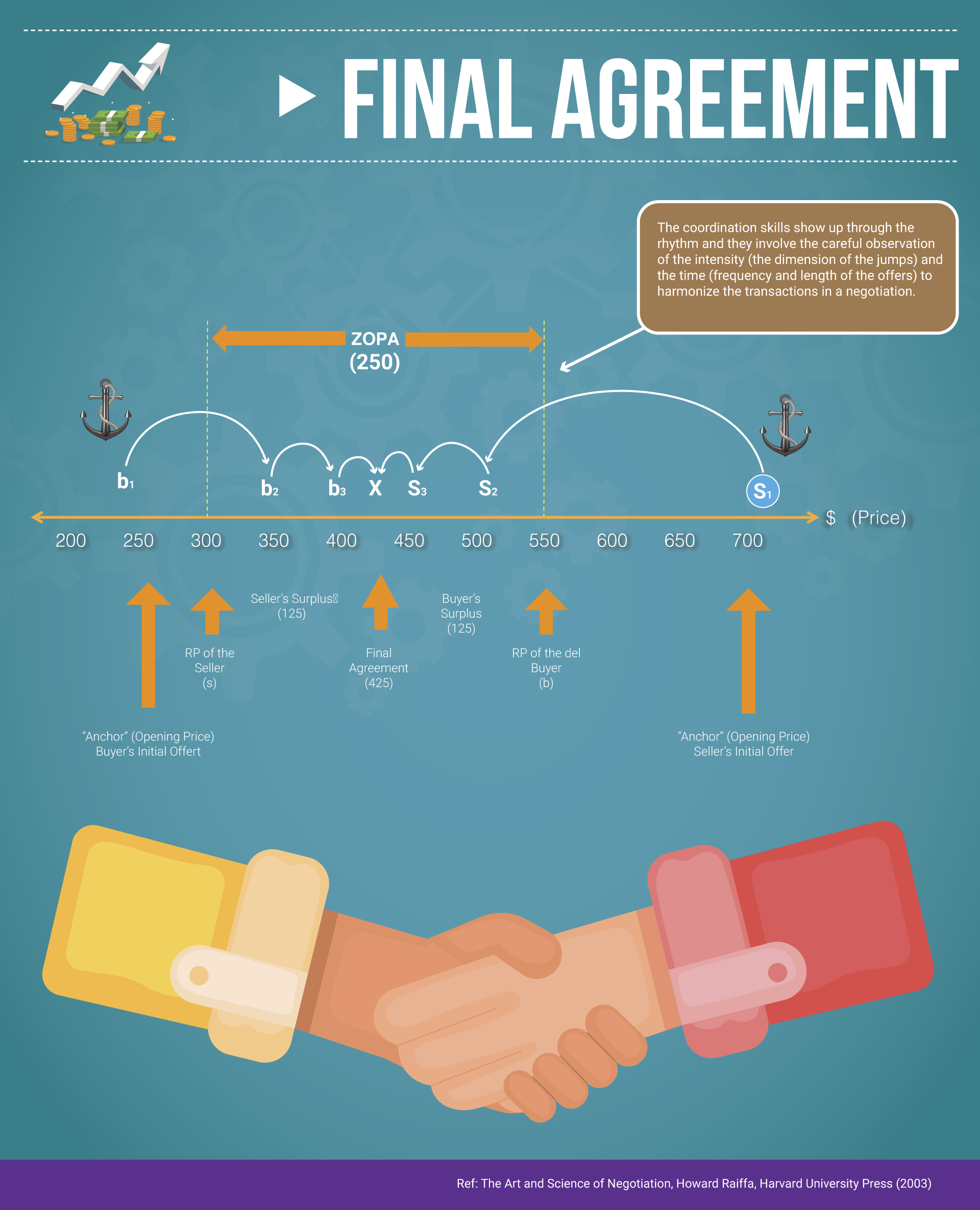Week 1 - Negotiation Analysis
Negotiation is a complex process of interactive communication in which the parties involved, based on contrasting postures and interests, try to reach an agreement that is mutually acceptable with respect to results and relationships.
Key concepts explained - Reservation Value, BATNA, ZOPA
Key concepts to understand before negotiating include:
- Reservation Value: The lowest amount a negotiator is willing to accept. This is confidential and not revealed to the counterpart.
- BATNA (Best Alternative To a Negotiated Agreement): The best alternative for the negotiator if the negotiation does not result in an agreement. It outlines what happens if the reservation value is not met.
- Objective: The interests behind the negotiator’s position.
Another critical term is ZOPA (Zone of Possible Agreement), which is the range between the buyer’s and seller’s reservation values. An agreement is likely when the ZOPA exists—that is, when the seller’s minimum acceptable price is less than the buyer’s maximum acceptable price. When these conditions aren’t met, there is no ZOPA but rather a ZONA (Zone of No Agreement), where the likelihood of agreement is low.
The process of negotiations
The Process of Negotiation is visualized as follows:
- The negotiator must decide the initial offer or “Anchor”, a critical step. There are differing opinions on whether it is advantageous to make the first offer.
- The choice of the anchor is strategic; if it’s far from the ZOPA, it can derail the negotiation.
- The “Negotiation Dance” begins with counteroffers and concessions made by both parties until they either reach an agreement or not.
If an agreement is reached, it will fall within the ZOPA, not necessarily in the middle. The total value that can potentially be shared between the negotiators is sometimes referred to as the “Pie”. A negotiation can be colloquially referred to as ‘win-lose’ based on how much of the ZOPA each party secures.
The stages of a negotiation
1) Preparation: Designing the architecture of the negotiation. 2) Opening: Tactics for setting the anchors carefully. 3) The Negotiation Dance: The phase of making counteroffers and concessions. 4) Closing/Final Agreement: The resolution and the distribution of the ZOPA. 5) Implementation of the agreement
Important terms/concepts
First an example and then you can find detailed terms explained below: Albert was admitted into a prestigious university in the US, located in a small town on the west coast. When he organized his studies, he realized that the labs were located a considerable distance from where he lived and there was not good public transportation. He considered asking his parents for help, but knew they had been paying his tuition and lodging, so he decided to talk to his roomie about the possibility of sharing expenses to buy a second hand scooter, advertised in one of the dorm halls at the university. The asking price was $700 (seller’s anchor)including a great helmet and chain lock. The seller had an urgent need to get rid of it because he was a recent graduate and already had a great job offer in the Big Apple (Nueva York). His traveling costs were $300 dollars (seller’s reservation value). On the other hand, Albert and his friend had managed to get together $550 dollas (buyer’s reservation value). Analyzing these values we find the ZOPA negotiation range to be $250 dollars ($550 - $300 = $250), so there is a good chance that they can reach an agreement.
*The buyer’s first offer is$200 dollars (buyer’s anchor). The buyer’s BATNA (alternative if there is no agreement reached) is to get a couple of bicycles for his roomie and himself. The seller’s BATNA is to leave the scooter in his girlfriend’s apartment and ask for a $300 dollar loan for his trip, hoping that she will eventually find a buyer for it.
Finally an agreement is reached because the ZOPA negotiation range is broad ($250 dollars) and the scooter is sold at $425 dollars, without the helmet or the chain lock.*
Reservation Value
This is the amount (price, for example) that a negotiator determines before going to negotiate. It is the limit beyond which he is not willing to continue negotiating. Per example the minimum amount that a seller is willing to accept for his property (the reservation value of the seller), or the maximum amount that a buyer is willing to pay for the goods (buyer’s reservation value). In principle these amounts are not revealed to the parties involved, who will try to obtain as much as possible of the goods that are being negotiated.
ZOPA
This acronym refers to Zone Of Possible Agreement, the range of a negotiation that potentially can be achieved in an agreement, and which is calculated by the difference between the buyer’s and seller’s reservation value. The ZOPA only exists when the reservation value of the buyer (maximum price that the buyer is willing to pay) is greater than the reservation value of the seller (minimum price the seller is willing to accept). When the opposite happens, we say there is a ZONA (Zone Of No Agreement) and it is unlikely that an agreement will be reached, since the maximum price the buyer is willing to pay doesn’t reach the minimum price that the seller is willing to receive.
ZOPA explained in more detail

BATNA
This acronym means Best Alternative To a Negotiated Agreement and refers to the alternative that the negotiator has if he can’t reach an agreement and backs out of the negotiation. Psychologically, it is a very important factor at the moment of negotiating because it gives the negotiator confidence, so he can realize his offers with greater objectivity, knowing that if the agreement isn’t reached, he has another option (his BATNA). Both BATNA and reservation values are very important factors that should be defined during the preparation phase of a negotiation.
ANCHOR
This is the first offer that is declared during the opening phase of a negotiation. The amount will be the reference point around which (hence the name anchor) successive offers will be made and anchoring carefully can decide the result of the agreement in favor of one of the negotiators. We will give more details about this variable later in the course
Manage the rhythm of negotiation
In this topic, the concept of the “Negotiation Dance” is introduced, focusing on the management of time and the intensity of offers, which are key components of the negotiation’s rhythm. Observing and registering the patterns of the other party’s movements is highlighted as a vital skill to improve negotiation results. The discussion uses a one-dimensional architecture of a distributive negotiation, commonly known as a “win-lose” negotiation. The text emphasizes that experience doesn’t necessarily guarantee knowledge and encourages modernizing negotiation skills by considering new social and strategic perspectives.
A metaphorical example is used involving stadium owners and a sports entrepreneur (baseball team owners). Despite both parties having calculated their reservation values (the least value they are willing to accept), their initial offers, or ‘anchors’, are far apart. The stadium owners wish to rent for $500,000 per year, while the team owners are accustomed to paying $120,000 and are initially only willing to raise their offer to $125,000. The stadium owners quickly counteroffer with $400,000, which is noted as a large concession relative to the team’s small increase.
This negotiation dance has two observed variables: intensity (size of concessions) and time (speed of responses). When the offers remain far apart, an “impasse” or recess may be necessary to rethink strategy and explore other alternatives. In this impasse, the concept of “Reframing” is introduced as a powerful tactic to change the perspective and objectives of the negotiation. For example, the stadium owners might emphasize the advantages of their modern, well-located stadium to persuade the team owners.
The topic also introduces the concept of “underconfidence” and “overconfidence” in negotiation, which are undesirable attitudes that can complicate the negotiation process. It is suggested to return to an open and constructive dialogue in such cases.
Furthermore, time management is stressed as being very important in a negotiation. The story exemplifies this with the stadium owners discovering that the team’s players are unhappy with their current stadium and considering a strike, while the team’s owners are considering additional uses for the new stadium, like creating a baseball training school.
The key takeaway is the importance of careful observation and documentation of patterns in a negotiation, such as the size and speed of concessions, and using this information, along with well-designed technical elements, to strategically inform the negotiation process.
The negotiation dance
The first offer is made, known as the anchor or opening of the negotiation. The term “rhythm” in the negotiation dance is the combination between the intensity or magnitude of each offer and the time taken to make them.
[[T-GjxCxpThiho8QsaX4YhQ_fd5d6cc5049a4e079ca39131e5861ea9_The-negotiation-dance.pdf|The Negotiation Dance]]

The effectiveness of a negotiation depends in great part to the communication skills of the negotiators.
The rhythm of the negotiation dance. For example, a quick jump on our part can alert the other negotiator, and cause him to think that he can take advantage of us and resist until he obtains better offers.
In reality, there is no conclusive evidence with respect to either of the postures explained, and the recommendation is to be careful when setting in the anchor value so it doesn’t derail the negotiation
